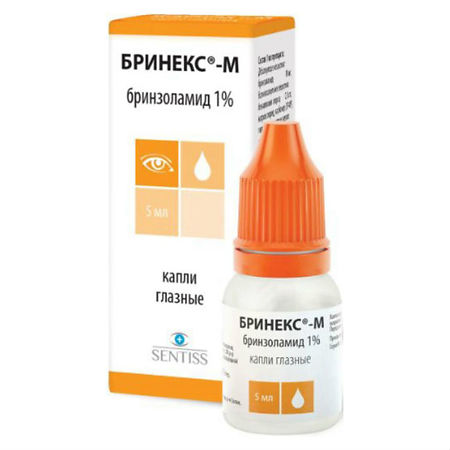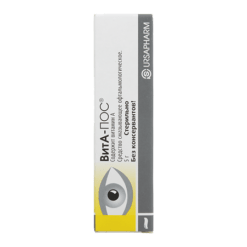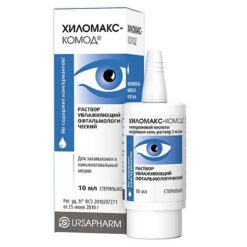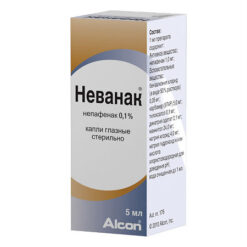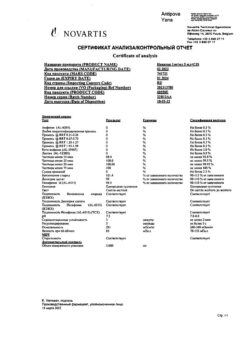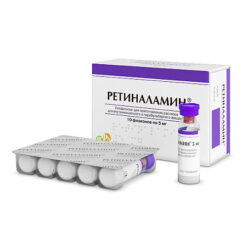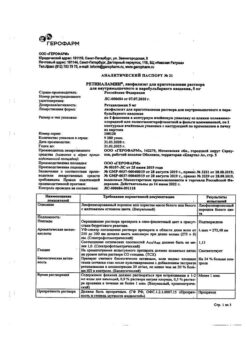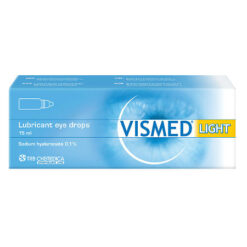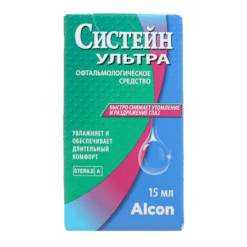No products in the cart.
Brinex-M, eye drops 1% 5 ml
€23.43 €19.52
Description
Increased intraocular pressure is the main risk factor for optic nerve damage and narrowing of the visual field.
Brinzolamide is an inhibitor of carboanhydrase II. Due to inhibition of carboanhydrase II formation of bicarbonate ions is slowed down with subsequent reduction of sodium transport in the fluid which leads to decrease of intraocular fluid production in the ciliary body of the eye. This results in a decrease in intraocular pressure (IOP).
Pharmacokinetics:
When applied topically, brinzolamide penetrates the systemic bloodstream. Brinzolamide is adsorbed in erythrocytes as a result of selective binding. A metabolite, N-dezethyl brinzolamide, is formed, which also binds to carboangidase and accumulates in erythrocytes. In the presence of brinzolamide, the metabolite binds primarily to carboanhydrase I.
In plasma concentrations of brinzolamide and its metabolite are below the limit of quantification (<10 ng/ml). The elimination half-life is 111 days. Binding to plasma proteins is about 60%. Brinzolamide is mainly excreted unchanged in the urine. The main metabolite (N-dezethylbrinzolamide) and low concentrations of other metabolites (N-desmethoxypropyl and O-desmethyl) are also detected in the urine.
Indications
Indications
Reduced intraocular pressure with:
open angle glaucoma,
ophthalmic hypertension.
As monotherapy in patients who do not respond to beta-blockers or in patients for whom beta-blockers are contraindicated.
As adjunctive therapy to β-blockers or prostaglandin analogs.
Pharmacological effect
Pharmacological effect
Increased intraocular pressure is a major risk factor for damage to the optic nerve and narrowing of the visual field.
Brinzolamide is a carbonic anhydrase II inhibitor. Due to inhibition of carbonic anhydrase II, the formation of bicarbonate ions is slowed down with a subsequent decrease in sodium transport in the fluid, which leads to a decrease in the production of intraocular fluid in the ciliary body of the eye. As a result, intraocular pressure (IOP) decreases.
Pharmacokinetics:
When applied topically, brinzolamide penetrates the systemic circulation. Brinzolamide is adsorbed in erythrocytes as a result of selective binding. A metabolite is formed – N-desethyl brinzolamide, which also binds to carbonic anhydrase and accumulates in erythrocytes. In the presence of brinzolamide, the metabolite binds primarily to carbonic anhydrase I.
Plasma concentrations of brinzolamide and its metabolite are below the limit of quantification (<10 ng/ml). The half-life is 111 days. Plasma protein binding is about 60%. Brinzolamide is excreted mainly unchanged in the urine. The main metabolite (N-desethylbrinzolamide) and low concentrations of other metabolites (N-desmethoxypropyl and O-desmethyl) are also found in urine.
Special instructions
Special instructions
Shake the bottle before use.
The bottle must be closed after each use.
Do not touch the tip of the pipette to any surfaces. The drug contains the preservative benzalkonium chloride, which can be absorbed by contact lenses. Before using the drug, the lenses should be removed and put back no earlier than 15-20 minutes after instillation of the drug.
System effects
Brinzolamide is a topical sulfonamide and carbonic anhydrase inhibitor but may be absorbed systemically. Sensitization of the body with sulfonamides can develop if the drug is re-prescribed in violation of the instructions for its use.
If serious adverse reactions occur or signs of hypersensitivity occur, the drug should be discontinued.
Acid-base imbalance has been reported when used concomitantly with oral carbonic anhydrase inhibitors.
Brinzolamide has not been studied in preterm neonates (less than 36 weeks’ gestational age) or in infants less than one week of age.
Patients with abnormalities or significant immaturity of the renal tubules should be treated with brinzolamide only after a careful assessment of the risk/benefit ratio, as there is a risk of developing metabolic acidosis.
Oral carbonic anhydrase inhibitors may impair the ability to perform tasks requiring mental alertness and/or physical coordination.
Concomitant therapy
There is a potential for increased known systemic effects of carbonic anhydrase inhibitors in patients when an oral carbonic anhydrase inhibitor is coadministered with brinzolamide. Their combined use has not been studied and is not recommended (See Interactions).
An initial evaluation of the combined use of brinzolamide with timolol during adjective glaucoma therapy was conducted. In addition, the IOP-lowering effect of brinzolamide was studied when combined with the prostaglandin analogue travoprost. There are no long-term data on the use of brinzolamide as an adjunct to travoprost therapy.
There is limited experience with the use of brinzolamide in the treatment of patients with pseudoexfoliation glaucoma or pigmentary glaucoma. Caution should be exercised when treating such patients, and close monitoring of intraocular pressure (IOP) is recommended.
Brinzolamide has not been studied in patients with narrow-angle glaucoma and is not recommended for use in such patients.
The possible role of brinzolamide in the functioning of the corneal endothelium has not been studied in patients with corneal disorders (especially in patients with low endothelial cell counts).
In particular, the use of brinzolamide in patients wearing contact lenses has not been studied; close monitoring of these patients is recommended when using brinzolamide as carbonic anhydrase inhibitors may affect corneal hydration and contact lens wear may increase corneal risk. Close monitoring of patients with corneal lesions, such as patients with diabetes mellitus or corneal dystrophy, is recommended.
There is evidence that benzalkonium chloride, which is commonly used as a preservative in ophthalmic products, causes punctate keratopathy and/or toxic ulcerative keratopathy.
Since Brinex®-M contains benzalkonium chloride, careful monitoring is required with frequent or prolonged use of the drug in patients with dry eye syndrome or conditions of corneal damage.
Benzalkonium chloride can also cause eye irritation and is known to discolor soft contact lenses. Contact of the drug with soft contact lenses should be avoided. Patients should be advised to remove contact lenses before using Brinex®-M and wait at least 15 minutes after dosing before putting on contact lenses.
The potential withdrawal syndrome following discontinuation of brinzolamide treatment has not been studied; The IOP lowering effect is expected to last 5-7 days.
Impact on the ability to drive vehicles. Wed and fur.:
If the patient’s vision temporarily decreases after using the drug, it is not recommended to drive a car or engage in activities that require increased attention and reaction until it recovers.
Active ingredient
Active ingredient
Brinzolamide
Composition
Composition
Composition of 1 ml of the drug:
Active ingredient: brinzolamide 10 mg
Excipients:
benzalkonium chloride 0.1 mg,
disodium edetate dihydrate 0.1 mg,
sodium chloride 2.5 mg,
tyloxapol 0.25 mg,
mannitol 33.0 mg,
carbomer (974P) 4.2 mg,
5M sodium hydroxide solution to pH 7.5,
1M solution of hydrochloric acid to pH 7.5,
water for injections up to 1 ml.
Pregnancy
Pregnancy
Fertility
Animal studies do not provide information on the effects of brinzolamide on fertility. No studies have been conducted to evaluate the effects of topical brinzolamide ophthalmic solution on fertility in humans.
Pregnancy
There is no reliable data regarding the use of brizolamide in pregnant women. Animal studies provide evidence of reproductive toxicity after systemic use.
Brinzolamide is not recommended for use during pregnancy or in women of childbearing potential who are not using contraception.
Breastfeeding period
It is unknown whether brinzolamide/its metabolites are excreted into breast milk after instillation into the conjunctival cavity. Animal studies have demonstrated the excretion of minimal levels of brinzolamide into breast milk following oral administration.
Due to the possibility of side effects in the nursing infant during maternal treatment with the drug, a decision should be made to discontinue breastfeeding or discontinue treatment, taking into account the importance of treatment for the mother and the importance of breastfeeding for the child.
Contraindications
Contraindications
Hypersensitivity to the active substance or to any of the excipients;
hypersensitivity to sulfonamides;
severe renal failure;
hyperchloremic acidosis.
With caution:
Caution should be exercised when using the drug in patients at risk of developing renal failure due to the possible development of metabolic acidosis.
The effect of brinzolamide on corneal endothelial function in patients with corneal disorders (especially in patients with low endothelial cell counts) has not been studied. Therefore, close monitoring of such patients while using brinzolamide is recommended.
Caution should be exercised when treating patients with pseudoexfoliation glaucoma or pigmentary glaucoma, and careful monitoring of IOP is recommended.
The use of the drug has not been studied in patients with angle-closure glaucoma or severe liver disease, so it should be prescribed to such patients with caution.
Side Effects
Side Effects
The frequency of adverse reactions given below is defined using the following frequency categories: very common (≥1/10); often (≥1/100 and <1/10); uncommon (≥1/1000 and <1/100); rare (≥1/10000 and <1/1000); very rare (< 1/10000); with an unknown frequency (which cannot be estimated from the available data). In each frequency group, adverse reactions are presented in order of frequency of occurrence.Data on adverse reactions were obtained from clinical studies and from post-marketing spontaneous reports.Infections and contaminations:Uncommon: nasopharyngitis, pharyngitis, sinusitis.With unknown frequency: rhinitis.From the hematopoietic system:Uncommon: decreased number of red blood cells, increased plasma chloride.From the immune system:With unknown frequency: hypersensitivity.Metabolism:With unknown frequency: decreased appetite.Mental disorders:Uncommon: apathy, depression, depressed mood, decreased libido, nightmares, nervousness.Rarely: insomnia.From the nervous system:Uncommon: motor dysfunction, amnesia, dizziness, paresthesia, headache.Rarely: memory impairment, drowsiness.With unknown frequency: tremor, hypoesthesia, ageusia.From the side of the organ of vision:Common: blurred vision, eye irritation, eye pain, foreign body sensation in the eye, ocular hyperemia.Uncommon: corneal erosion, keratitis, punctate keratitis, keratopathy, accumulations in the eye, corneal staining, corneal epithelial defect, violations of the integrity of the corneal epithelium, blepharitis, eye itching, conjunctivitis, conjunctival edema, meibomitis, photophobia, dry eye syndrome, allergic conjunctivitis, pterygium, scleral pigmentation, asthenopia, discomfort in the eyes, unusual sensation in the eye, sicca keratoconjunctivitis, subconjunctival cysts, conjunctival injection, itching of the eyelids, discharge from the eyes, crust on the edges of the eyelids, lacrimation, accumulation of pigment in the cornea during diagnostic tests to confirm the violation of the integrity of the corneal epithelium.Rarely: corneal edema, diplopia, decreased visual acuity, photopsia, hypoesthesia, edema of the periorbital region, increased intraocular pressure, change in the ratio of the excavation diameters to the diameter of the optic nerve head.With unknown frequency: corneal disorders, visual disturbances, allergic reactions of the eyes, madarosis, eyelid disorders, eyelid erythema.From the organ of hearing and labyrinth:Rare: ringing in the ears.Unknown frequency: dizziness.From the cardiovascular system:Uncommon: cardiorespiratory distress syndrome, bradycardia, palpitations.Rarely: angina pectoris, heart rhythm disturbances.With an unknown frequency: arrhythmia, tachycardia, hypertension, increased blood pressure, decreased blood pressure, increased heart rate.Respiratory, thoracic and mediastinal disorders:Uncommon: shortness of breath, nosebleeds, oropharyngeal pain, pharyngolaryngeal pain, throat irritation, upper respiratory tract cough syndrome, runny nose, sneezing.Rarely: bronchial hyperactivity, feeling of congestion in the upper respiratory tract, swelling of the mucous membrane of the paranasal sinuses, nasal congestion, cough, dry nose.With unknown frequency: bronchial asthma.From the gastrointestinal tract:Common: dysgeusia.Uncommon: esophagitis, diarrhea, nausea, vomiting, dyspepsia, upper abdominal pain, abdominal discomfort, stomach discomfort, flatulence, frequent bowel movements, gastrointestinal disorders, decreased sensitivity in the mouth, paresthesia in the mouth, dry mouth.From the hepatobiliary system:With unknown frequency: changes in liver function test results.From the skin and subcutaneous fat:Uncommon: rash, maculopapular rash, feeling of skin tightness;Rarely: urticaria, hair loss, generalized itching;With unknown frequency: dermatitis, erythema.From the musculoskeletal system and connective tissue:Uncommon: back pain, muscle spasms, myalgia.With unknown frequency: arthralgia, pain in the extremities.From the side of kidney and urinary tract function:Uncommon: pain in the kidney area.With unknown frequency: pollakiuria.From the reproductive system:Uncommon: erectile dysfunction.General violations:Uncommon: pain, chest discomfort, fatigue, unusual sensations.Rarely: chest pain, anxiety, asthenia, irritability.Unknown frequency: peripheral edema, malaise.Injuries, poisoning and complications during instillationUncommon: sensation of a foreign body in the eye.Description of individual adverse reactions:Dysgeusia (bitter or unusual taste in the mouth after drug instillation) was the most common systemic adverse reaction associated with brinzolamide during clinical trials. This is probably due to the passage of eye drops into the nasopharynx through the nasopharyngeal canal.Nasolacral occlusion or gentle closure of the eyelids after instillation may help reduce the incidence of this effect (see Dosage and Administration).Brinzolamide is a sulfonamide and carbonic anhydrase inhibitor with systemic absorption.Adverse reactions from the gastrointestinal and nervous systems, as well as hematological, renal and metabolic side effects are usually associated with the systemic action of carbonic anhydrase inhibitors. The same type of adverse reactions that may be associated with oral carbonic anhydrase inhibitors may also occur with topical use.No unexpected adverse reactions were observed when brinzolamide was used in combination with travoprost. Adverse reactions observed during co-therapy were related to each of the active substances.
Interaction
Interaction
Specific studies of the interaction of Brinex®-M eye drops with other drugs have not been conducted.
Concomitant use with oral carbonic anhydrase inhibitors is not recommended, as there is a possibility of increased systemic adverse reactions.
Salicylates in high doses increase the risk of systemic adverse reactions.
In clinical studies, brinzolamide was used concomitantly with prostaglandin analogues and timolol ophthalmic drugs without evidence of adverse interactions. The interaction between brinzolamide and miotics or adrenergic agonists has not been evaluated during co-therapy for glaucoma.
Brinzolamide is a carbonic anhydrase inhibitor and, although administered topically, is absorbed systemically. Acid-base imbalance has been reported when used concomitantly with oral carbonic anhydrase inhibitors. An assessment of the potential for interaction is necessary.
Cytochrome P-450 isoenzymes involved in the metabolism of brinzolamide: CYP3A4 (major), CYP2A6, CYP2C8 and CYP2C9. CYP3A4 inhibitors such as ketoconazole, itraconazole, clotrimazole, ritonavir and troleandomycin are expected to inhibit the CYP3A4 metabolism of brinzolamide.
Caution should be exercised when co-administering brinzolamide with CYP3A4 inhibitors. Accumulation of brinzolamide is unlikely since it is excreted primarily by the kidneys. Brinzolamide is not an inhibitor of cytochrome P-450 isoenzymes.
Overdose
Overdose
There is no information about symptoms of overdose with topical use. When taking the drug orally, electrolyte imbalance, development of acidosis, and nervous system disorders may occur.
It is necessary to monitor the level of electrolytes (especially potassium) and the pH value of the blood.
Storage conditions
Storage conditions
At temperatures from 4 to 30 °C.
Keep out of the reach of children.
Shelf life
Shelf life
2 years.
Manufacturer
Manufacturer
Sentiss Pharma Pvt.Ltd, India
Additional information
| Shelf life | 2 years. |
|---|---|
| Conditions of storage | At a temperature of 4 to 30 ° C. Store out of the reach of children. |
| Manufacturer | Sentiss Pharma Pvt.Ltd, India |
| Medication form | eye drops |
| Brand | Sentiss Pharma Pvt.Ltd |
Related products
Buy Brinex-M, eye drops 1% 5 ml with delivery to USA, UK, Europe and over 120 other countries.

